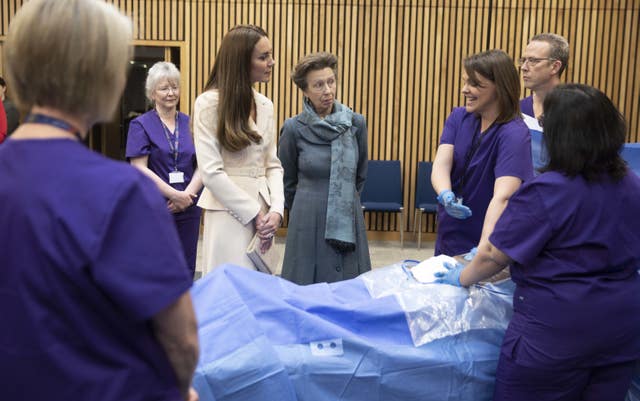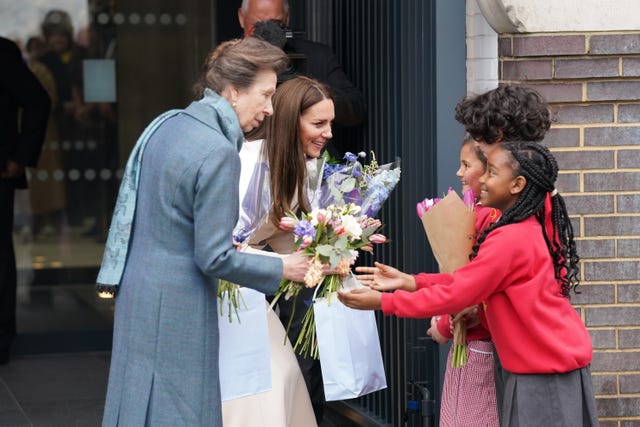The Princess Royal left midwives and the Duchess of Cambridge in stitches when she recalled fearing one of her babies had become “wedged” when she tripped over in a horse lorry while heavily pregnant.
The Queen’s daughter was chatting to maternity experts during a visit to the new headquarters of her patronage, the Royal College of Midwives (RCM), which is also home to the Royal College for Obstetrics and Gynaecology (RCOG) – and which Kate supports as patron.
The royal women were shown a demonstration of a new Intrapartum Foetal Surveillance tool, which monitors the safety of babies during labour in order alert medical staff to start a delivery if the baby’s head gets stuck in the mother’s pelvis.

“Wedged?” asked Anne, to laughter.
The princess – who is a mother to Peter Phillips, 44, and Zara Tindall, 40 – then told the group how she feared that would happen to her during one of her pregnancies, adding: “I thought, that’s a bit interesting… ended up the right way up though.”
Professor Tim Draycott, vice president of RCOG and Professor of Obstetrics – who was helping to demonstrate the tool, said later: “She said she had tripped over in a horse lorry while heavily pregnant and thought that had happened.”
The tool has been developed over the past five years by the Avoiding Brain Injury in Childbirth collaboration, which hopes to pilot it later this year and roll it out nationwide in 2023.

The duchess and the princess watched Dr Katie Cornthwaite, an obstetrics and gynaecology registrar, give a demonstration of new training for health workers faced with delivering, via caesarean, an infant whose head is wedged in the pelvis – an issue that is a growing litigation problem for the NHS.
Professor Draycott acted as the anaesthetist for the pretend mother, standing by her head, but was actually pushing the model of the baby through for his colleague.
Anne made the medical staff laugh when she quipped: “You do this with just an epidural?”.
At one point, the duchess and princess leaned forward to peer into the caesarean opening as Dr Cornthwaite described in detail how she removed the dummy baby.
Prof Draycott said later what is known as “impacted foetal head” was becoming a “huge” problem for the NHS, which has been facing lawsuits following difficult births where the baby has suffered trauma around the head.
He said: “I think this is a really good example of the NHS working well. NHS resolution who do all the litigation identified this as an emerging problem, the Department of Health worked with the professionals to say ‘OK what are we going to do about this, lets design a new training programme. Let’s get this sorted out. Let’s stop babies being injured’.”
Dr Cornthwaite said afterwards: “It was really lovely to see how engaged they both were. They were genuinely interested. It was lovely to share something that we are passionate about and see that they care about it.”

Anne, as the senior royal, appeared to take the lead during the rare joint engagement, asking most of the questions and sharing her knowledge about the midwifery sector.
When she sat down with Kate and the global health teams from RCOG and the RCM, Anne brought up the issue of how mothers are sometimes kept in the dark about their treatment by the medical profession.
She said: “Pregnant women, they should know just as much as everybody else does but they’re seen, as I’ve said before, ‘you’re seen as a patient you don’t need to be part of the answer’.”
The royal women also met groups of award-winning midwives recognised by the RCM for their outstanding achievement and commitment.
At one point, the Princess Royal asked one woman how long she had been working as a midwife, and when told “20 years” replied “we need more like you”.
Before leaving the royal women unveiled a plaque to mark the opening of the building.




Why are you making commenting on The National only available to subscribers?
We know there are thousands of National readers who want to debate, argue and go back and forth in the comments section of our stories. We’ve got the most informed readers in Scotland, asking each other the big questions about the future of our country.
Unfortunately, though, these important debates are being spoiled by a vocal minority of trolls who aren’t really interested in the issues, try to derail the conversations, register under fake names, and post vile abuse.
So that’s why we’ve decided to make the ability to comment only available to our paying subscribers. That way, all the trolls who post abuse on our website will have to pay if they want to join the debate – and risk a permanent ban from the account that they subscribe with.
The conversation will go back to what it should be about – people who care passionately about the issues, but disagree constructively on what we should do about them. Let’s get that debate started!
Callum Baird, Editor of The National
Comments: Our rules
We want our comments to be a lively and valuable part of our community - a place where readers can debate and engage with the most important local issues. The ability to comment on our stories is a privilege, not a right, however, and that privilege may be withdrawn if it is abused or misused.
Please report any comments that break our rules.
Read the rules here